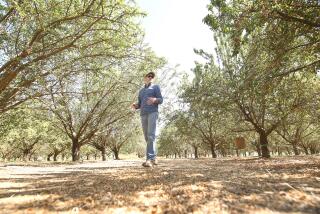Walnut Crop Is Fading as Farmers Turn to Citrus : Agriculture: Only 250 acres of the once-plentiful trees remain. Some see the industry’s demise due to irrigation, disease and other problems.
A roaring clatter sounds from the hopper of a vintage walnut huller at Rancho Shangri-La in the upper Ojai, as a load of nuts hits sheet metal. The noise might as well be the crop’s death rattle.
Walnuts, which once stretched across 15,000 acres in Ventura County, are down for the count. Most commercial growers have long since pulled them and have planted citrus trees in their place. Counting this 40-acre spread, perhaps 250 acres of aging walnut trees remain, and their number is dwindling.
“Walnuts did very well in the ‘40s and ‘50s,” said Ben Faber, University of California farm adviser in Ventura. “Then they started getting navel orange worm and husk fly, and that made it more expensive, since they had to start using insecticides. Everybody started saying, ‘Let’s get out of this business and find something that will pay more.’ ”
By the early ‘60s, half of the county’s walnuts had disappeared. Now the vast majority of the state’s 225,000 tons of walnuts--two-thirds of the world’s supply--are raised in the state’s Central Valley, where land is less expensive and the cold winters stimulate the growth of buds.
At Tierra Rejada Ranch in Moorpark, two acres of a 65-acre walnut orchard remain.
“Production was never all that great,” said manager Richard Brecunier. “The returns just weren’t justifying keeping them. We felt we could do better with other crops.”
The ranch, a member of Diamond Walnut Growers, sold its crop to the co-op’s Saticoy packing plant. But as acreage declined, Diamond followed the crop north, and members had to truck their crop to Buellton or find independent buyers. The upsurge of the husk fly in the past several years was the final strike.
“They’re pretty trees and we hate to have to cut them down,” Brecunier said. But “it’s like any other business--changes are being forced on us. You have to do what you have to do.”
Shangri-La is a holdout, perhaps the biggest walnut orchard left in the county.
“You don’t have to water them and you don’t have to feed them,” said Betty DeBusschere, ranch co-owner and harvest supervisor. “That’s hard to beat.”
The trees, with their massive root systems, are one of the few crops that can survive on Southern California rainfall. And the ranch is certified organic, a fact that ensures a substantially higher price for nuts, and a few more struggles with pests.
These trees are 40 years old, not yet halfway to walnut mortality if conditions stay moderately good. But with a prolonged drought and the freeze of ‘92, walnuts haven’t been ideal for much of the past decade. And the current harvest looks scant.
“We had that heat in August just too many days in a row. It could have been a bumper crop, but it’s a sunburned crop,” DeBusschere said, fingering the nuts’ shriveled hulls.
At least the shaker is operating this year. The ancient harvesting machine, owned by a local contractor, is driven from ranch to ranch, where it toils down walnut rows, gripping trunks in a giant vise and vibrating the trees to create instant nut showers.
For the past five years, the machine has been out of commission and ranchers have shaken the crops from 60-foot trees with poles. No one wants to invest in a shaker because the vibration continually disables the mechanism, DeBusschere said.
When the nuts hit the ground, another challenge faces the grower: finding pickers. Those who supply workers for other crops are not inclined to round up crews for the small nut harvest. Picking the crop from the ground and avoiding the sun-blackened nuts is not a choice job.
“I went down to town and picked up some workers yesterday. When I explained the work, they didn’t want to do it. I had to take them back down again,” DeBusschere said.
Today, a few workers are filling bags of nuts, and the grower has hopes of completing the harvest within another week. She has contacted the wholesaler who paid $3 a pound for nut meats last year, but “I don’t know if I’m going to have enough for him to bother with,” she said.
A couple of miles from Shangri-La is a more typical Ventura County walnut ranch--a five-acre parcel owned by Bonnie Brown, who has had the property 20 years.
Here, three generations of the family has picked the crop, removed the hulls in a cement mixer containing rocks, then cracked the shells with hammers. Brown’s parents, now octogenarians, are planning to return from Los Angeles for the harvest.
“I can remember when (walnuts) were almost throughout the upper Ojai,” said Brown, who sits on the Ventura County Agriculture Commission advisory board. “Now, the water table’s vanishing and (irrigation) is too costly. That’s what’s going to do them in.”
She expects a few old customers to come to the ranch with picnic lunches and gather a winter’s supply of nuts. The rest of the crop will go to local bakeries or markets.
“These are majestic trees,” Brown said. “We like ‘em and we try and make do. With the water going, they’re stressing. And if they stress, they are susceptible to diseases, crown rot and all kinds of things when it does rain. We’re finding a lot of crown rot now.
“They need to be coddled. People say, ‘Oh, walnuts, that’s nice.’ They do fine for a couple of years, and then they don’t do so well, and they take them out.”
Brown sees a bleak future for the industry.
“It’s fast fading,” she said. “It’s big-time going to be out of this county before my children have children.”
More to Read
Sign up for Essential California
The most important California stories and recommendations in your inbox every morning.
You may occasionally receive promotional content from the Los Angeles Times.









